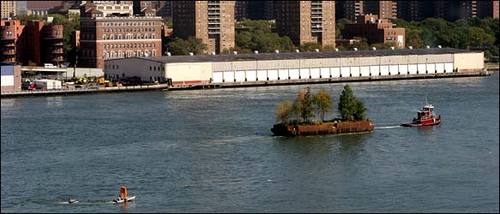
A little while back, when I realized that Bruce High Quality Foundation, the ambiguous, anonymous art collective and The New Hotness, were behind The Gate, I took them at their word and began to question whether what we knew or assumed about the project was true, misinformation, or both. As they put it,
When there are moments of clear misinformation, those are generally used to make people be more conscious of the potential that it’s all made up. They have a function so that you always know it has been written by someone somewhere.
Specifically, I wondered if the fantastic and seemingly serendipitous documentation of The Gate and the front page NY Times article by Randy Kennedy that followed were, if not fabricated, then at least planted, managed, manipulated or produced in some way by BHQF.
I should say that at the time, I was also writing arts features for the NYT. Though I don’t know Randy Kennedy personally, I have a huge admiration for his work. My questioning of how the The Gate story was presented should in no way be construed as casting doubt on Kennedy.
But just imagine a publicist were involved. And/or that the Brooklyn designers who photographed and witnessed The Gate were friends or even enlisted participants of BHQF members. The contours and details of Kennedy’s article could be entirely accurate, and from a journalistic standpoint, he’d be totally in the clear.
What would change is the perception and interpretation of BHQF and their work. What if Bruce–who, at the time, refused even to identify themselves as BHQF–had a publicist who helped them get their project into the NY Times? It’s as far-reaching as it is far-fetched.
More plausible, though, would be the idea of setting up not just the execution of The Gate, but its publicity. The Gate‘s $2,000 budget was a challenge to the conflation of budget and value in public art. Christo and Jeanne-Claude’s Gates had been loudly–and, I argued, inaccurately–presented as a $20 million “gift” of the artists to the public. Robert Smithson’s widow Nancy Holt allowed his scruffy Floating Island to be realized posthumously with a $250,000 budget, which organizers touted as the “anti-Gates.”
This was the context for BHQF’s brilliant, absurdist, and flagrantly shoestring idea. But the question seems obvious, even intrinsic: if a floating gate chases a floating park and the Times doesn’t cover it, is it public art?
So anyway, I contacted the two designers who were the Times’ sources for the The Gate article, and I asked them more about their experience as BHQF’s first audience. Basically, it all checks out. Here are some excerpts from their email accounts:
From Kennedy’s NYT article:
Elizabeth Elsas, went down to the waterfront, where the motorboat driver and a man with a video camera who had been towed behind the motorboat were already getting out of the water. A crowd of supporters were waiting, as if to receive Lindbergh after crossing the Atlantic. But the would-be art pirates, whom she described as being in their 20’s and “art studenty,” were not forthcoming with their identities or even particularly friendly.
“They said that they do some public art pieces themselves, and they thought the ‘Gates’ project was stupid and kind of wanted to comment on public art and make a joke about it,” Ms. Elsas said, adding that, apparently, this joke was not meant to be funny.
“We were laughing about it,” she said. “But they weren’t laughing.”
Elizabeth Elsas Mandel is a graphic designer and is currently a professor of graphic design at SCAD-Atlanta. Here’s what she told me:
It is true that my studio-mates and I unexpectedly noticed The Gate out of the window of our studio on Jay Street in Dumbo. We had the schedule on the wall of when the Smithson project was supposed to pass by our window each day. When we saw the Gate, another designer who worked in the studio and I went down to see it up close, but we didn’t call the Times. If I remember correctly, Ian emailed the photo he took to some friends, and someone ended up forwarding it to Randy Kennedy. Kennedy called Ian for some comments, and he directed the call to me.
Ian is Ian Adelman, now the design director for NY Magazine, and the “one man in the twenty-somethingth floor of an office building in DuMBo,” whose photo of The Gate, as BHQF puts it, “took on a life of its own.” Here’s Ian:
FWIW. I can assure you that I do not know, and haven’t met, associated with, or otherwise been connected to the artists known as BHQF. The description of the event as published in the Times is accurate and the actions taken by those of us in the studio (on the 8th floor, btw) of the DUMBO building was influenced in no way beyond reacting to that which played out in our East River view. Those guys just got really fucking lucky – what a coup!
So I was right, it wasn’t the twenty-somethingth floor after all! Ahem. And what does Ian get for his inadvertently formative role in launching BHQF? A completely made up shoutout in their book:
As for the narrative found in the BHQF book – the one about “Ian Adelman” – that’s just a fanciful bauble created by people who pretty clearly don’t know me. Some sort of ultra-mundane fan fiction – but fiction it is. (Also: the only reason I even know about the fan fiction piece is that a writer I know gave me a copy.)
And there you have it, way more BHQF news than was fit to print five years ago.
